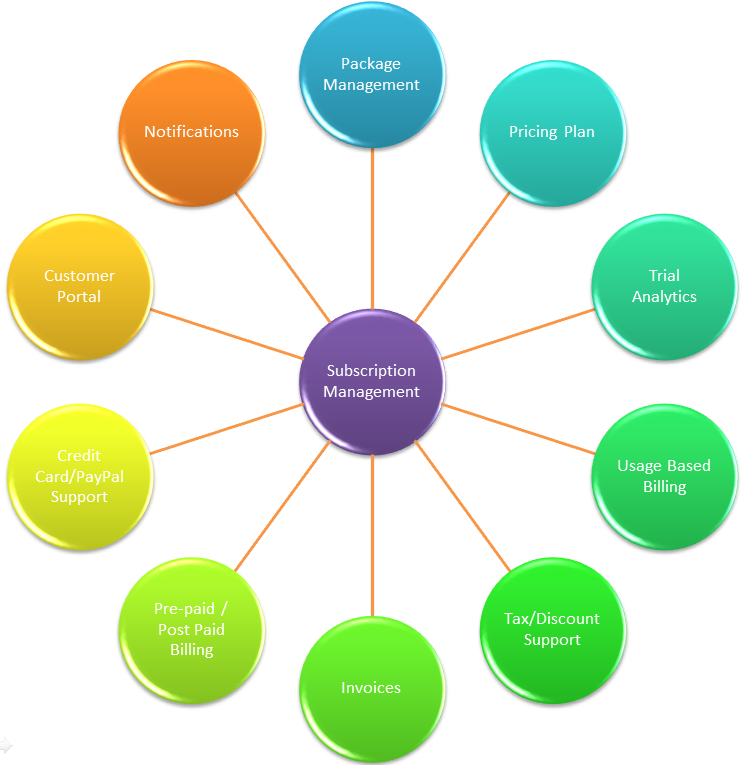Subscription management encompasses a wide area of operational activities involved in a SaaS business model. While there are several subscription management solutions available in the market, there is no clear guideline to benchmark them. In this blog I am going to discuss on the Top 10 key features one should look for while deciding on a Subscription Management Solution.
Feature #1 – Package Management
It’s very common to see multiple editions of the product addressing the various segments of target customers. The same holds good for a SaaS product. This feature should allow you to create a package by grouping the modules available in your SaaS product. Please note that this feature can help ISVs price their modules individually, which will benefit both ISVs and customers.
Feature #2 – Pricing Plan
This is one of the most complex features in subscription management. ISV should be able to define multiple price plans for the same package. For example, Document Management System – Premium Package can have 3 pricing plans. Monthly Plan at $40, Quarterly Plan at $100 and Yearly Plan at $300. Therefore, the same package can be chosen under 3 different subscription models.
Feature #3 – Trial Analytics
All SaaS products support trials that can be used by potential customers to evaluate the SaaS application. Subscription management system should allow an ISV to create subscriptions with trial support. For example, I can create a Silver Package with trial for 20 days. When a customer signs up to this subscription they will get the first 20 days as free and the billing will apply only from the 21st day. In some cases ISVs can also decide to offer a lighter version as completely free forever. This scenario should also be supported. However, the most interesting feature is on the insights that ISVs can get through Tenant Analytics. It’s very important to increase your conversion rate i.e. from trial customers to paying customers. In order to do this, you need 2 important data points. #1 Hot Trials (or leads) recording a high usage of your system, which means they are in the happy path #2 Trials recording low usage of your system, which means they are either not happy about what they see or is stuck up with some road block. These analytics can help ISV tackle any customer volume without resource constraints.
Feature #4 – Usage-based Billing
Value based pricing models provides an attractive pricing model for SMB segment. Traditional pricing models have a fixed $ price regardless of the usage of system by Customer. With Value based pricing model the customer gets charged based on certain attributes that can reflect the amount of usage by that customer. For example, in a SaaS based recruitment system customer can be charged based on the number of candidates ($X per candidate) recruited through the system. In a trading system it could be a % of the total value of transaction that was performed in the system. Pricing plan can describe how this metered data should be used for cost calculation. Slab based pricing and Fixed cost pricing are 2 common ways used in the industry. For example, Fixed cost could be $25 for each person recruited through the system. Whereas for the trading system it could be 1% upto .5mn, 0.8% for >.5mn and <1mn, 0.5% for >1mn, which is a slab based pricing.
Feature #5 – Tax/Discount Support
Tax and Discount components are vital in an invoice. In case of Tax, the tax elements and their values can change from customer to customer. For example, sales tax in US can change from state to state and hence, it has to be configurable. Discounts can also appear as line items in invoices. ISVs can publish various discount codes, which can be applied by the customers. Each discount code has a validity and % discount. Once the code is applied appropriate discount should reflect in the invoices. In some cases Discount line items can also be used for manual cost adjustments.
I will cover the remaining 5 features in the next blog. Feel free to reach me out at [email protected] to share your feedback.
- Top 10 NFR in Software Architecture – Part 1 - December 1, 2022
- Top 10 Critical NFR for SaaS Applications – Part 2 - October 20, 2022
- Why enterprises should standardize Digital Application Management - July 17, 2017







Comments